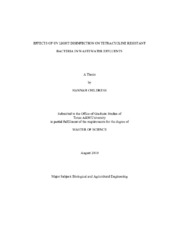| dc.description.abstract | The ubiquitous use of antibiotics has led to an increasing number of antibioticresistant
bacterial strains, including strains that are multidrug resistant, pathogenic, or
both. Numerous studies have been conducted showing the presence of antibioticresistance
genes (ARGs) and antibiotic-resistant and multidrug resistant bacteria in
wastewater and drinking water treatment plants. There is also evidence to suggest that
ARGs spread to the environment, and to humans and animals, through wastewater
effluents. The overall objective of this study was to investigate the effect of UV light
disinfection on ARGs and antibiotic resistant bacteria.
Wastewater effluent samples from a wastewater treatment plant (WWTP) in
Texas were evaluated for differences in abundance and diversity of tetracycline resistant
bacteria before and after UV treatment. The effects of photoreactivation or dark repair
on the reactivation of bacteria present in WWTP effluent after UV disinfection were also
examined. Culture based methods were used to characterize viable heterotrophic,
tetracycline resistant heterotrophic, E. coli, and tetracycline resistant E. coli bacteria
present before and after UV treatment. Molecular methods were used to characterize the diversity of organisms present and to test for the presence of tet(Q), a tetracycline
resistance gene associated with human origins.
UV disinfection was found to be as effective at reducing concentrations of
resistant heterotrophs and E. coli as it was at reducing total bacterial concentrations. The
lowest survival ratio following UV disinfection was observed in tetracycline-resistant E.
coli, showing it to be particularly susceptible to UV treatment. Photoreactivation and
dark repair rates were found to be comparable to each other for all bacterial populations.
UV disinfection was found to significantly alter the community composition of
tetracycline-resistant bacteria, though it did not have the same effect on the total
bacterial community. | en |


